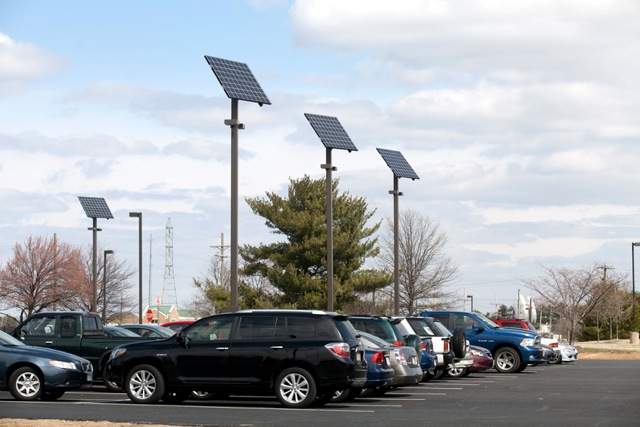Army, GSA aim for 'net zero' energy use
Service expands energy-use agenda

Fort Detrick's 'net zero' energy-use program promotes building efficiency upgrades, water recycling and reducing the amount of waste sent to landfills. The post put solar panels in its parking lots to help power nearby facilities such as a gym. (Army)
Since early 2011, the Army’s Fort Detrick, Md., has been on a mission to use only as much energy as it produces by fiscal 2020. It has installed energy-efficient lighting and upgraded boilers and is planning to construct a solar field that produces 20 megawatts of solar power.
The progress that Fort Detrick and 16 other installations have made in becoming more energy-efficient and environmentally conscious has led the Army to begin expanding its “Net Zero” program to all 156 of its installations by the end of the year.
Richard Kidd, the Army’s deputy assistant secretary for energy and sustainability, said the idea of using only as much power as the base produces will be embedded in each installation’s master plan, construction and design programs and even waste and recycling efforts.
“All of the things we do at our installations will have that ‘Net Zero’ philosophy,” Kidd said.
In addition to net-zero energy use, the program promotes water recycling and reuse to avoid depleting local water sources and reducing to zero the amount of waste sent to landfills by instead recycling, composting or turning waste into energy. Installations participating in the program can focus on one or more of the three categories.
Fort Detrick has projects in all three categories. The installation put in solar panels in its parking lots to help power nearby facilities such as a gym, and it reuses water for landscaping. It also recycles more than 46 percent of its waste and burns 90 percent of the remaining waste to produce steam to heat facilities, according to the installation. It worked with contractor Constellation Energy to install new heating and cooling systems, as well.
Among other installations that have begun projects to reach their 2020 goals:
* Fort Carson, Colo., has installed energy-efficient lighting systems and is building a central plant to help power its facilities with more efficient traditional sources of energy. The installation also contracted with Xcel Energy, Colorado Springs Utilities and the Western Area Power Administration to develop about 150 megawatts of renewable energy, including solar panels and wind power.
* Kwajalein Atoll in the Pacific Ocean’s Marshall Islands recovers heat from its utility plant to help heat nearby facilities and contracted to build about 17 megawatts of wind and solar power.
* Fort Hunter Liggett, Calif., contracted with Sierra Energy to build a small-scale waste-to-energy system as part of a pilot project and is installing energy-efficient lights.
The Army and agencies across the government are under pressure to meet a variety of energy-efficiency and environmental goals, including increasing renewable energy use, reducing building energy and water use, and cutting greenhouse gas emissions.
The Army has also said one gigawatt of its energy will come from renewable sources by 2025.
Katherine Hammack, assistant secretary of the Army for installations, energy and the environment, said at a public forum June 6 that the Net Zero program pushes the Army to go beyond meeting basic environmental mandates and goals in favor of more comprehensive efforts. The program saves taxpayer money, especially in times of fiscal challenges, uses resources more wisely and efficiently, and reduces the Army’s impact on the environment, she said.
And producing as much energy as the installation needs helps prevent a shutdown in case of a natural disaster or an attack, she said.
“To us, better managing your energy and water, or becoming more sustainable, increases our resilience over those things that we don’t have control of,” she said.
The General Services Administration is also pushing to construct net-zero facilities and cut energy use when it renovates older buildings.
In February, GSA rededicated the 95-year-old Wayne N. Aspinall Federal Building and U.S. Courthouse in Grand Junction, Colo., after contractor The Beck Group worked with the agency to complete $15 million in renovations that made it the first net-zero GSA-owned building on the National Register of Historic Places.
The facility has highly efficient lighting and mechanical systems that allow it to use half as much energy as a conventional building and comes with 385 solar panels on the roof to generate electricity.
“It’s been a unique project in that we’ve converted the building into a model of energy efficiency and sustainability, while preserving its original character,” said GSA Region 8 administrator Susan Damour in a news release.
All content © 2013, Gannett Government Media Corporation
http://www.federaltimes.com/apps/pbcs.dll/article?AID=2013306260008